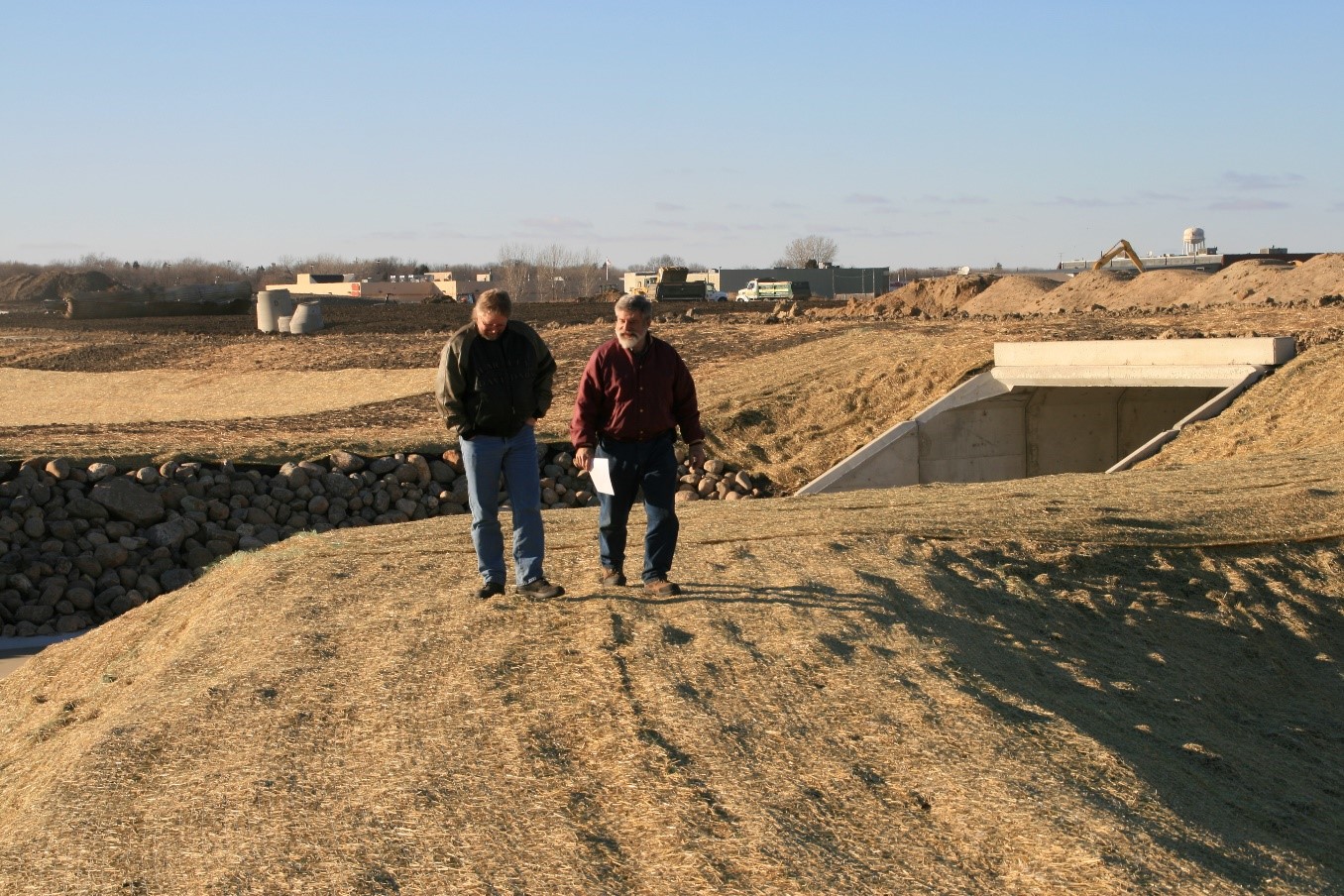This the fifth post in the Gorans Blog Series about the Gorans Discovery Farm Project. You can read the previous posts here.

We’ve explored how weather impacts the amount of runoff and drainage and how nutrient input impacts yields. But for many, the heart of the issue is how much sediment and nutrients are being carried in that runoff and drainage water into the waterways.
Comparing the Fertilized Field and Unfertilized Field
We first want to discuss and compare the two fields, one you’ll remember was fertilized and the other was not. We know commercial fertilizer and manure (in this case, turkey manure) are important nutrient sources for crop production. However, we also know there is a lot of concern around nutrients from those sources leaving the fields in water drainage and impacting water quality.
We found the extent of water quality degradation due to fertilizer application was not well documented when it came to subsurface-drained soils, like our fields. That’s why we decided to do the work ourselves and compare the two. To do this, we first focused on the impact of manure and fertilizer application on total suspended solids (sediments – TSS), total phosphorus (TP).
Total Suspended Solids (TSS)
We found the median concentration of TSS for the Unfertilized Field (5 ppm) was 2.2 times higher than the Fertilized Field (2.3 ppm). There was less crop residue present (based on visual observation) in the Unfertilized field resulting in more erosion and higher sediment measurements. The sediments entered the drainage water through surface inlets. The Fertilized Field had more crop residue present, reducing the amount of erosion.
Total Phosphorus (TP) Concentration
The median total phosphorus concentration was 1.9 times higher in the Unfertilized Field (0.19 ppm) compared to the Fertilized Field (0.10 ppm). This is despite the fact that the soil test for phosphorus was lower in the Unfertilized Field. Because total phosphorus measurements of the drainage water includes particulate phosphorus, we suspect the larger amount of sediment (TSS) in the water from the Unfertilized Field resulted in larger amounts of phosphorus. In other words, more sediment means more total phosphorus entering through the surface inlets and into the water.
Loads of Phosphorus and Sediments
To calculate the loads, we used the concentrations of phosphorus and sediment and multiplied that by the volume of water coming from the fields. When we look at the loads per unit area (lbs. per acre) they were significantly higher in the Unfertilized Field compared to the Fertilized Field. Again, we concluded that this was because of the different amount of crop residue and erosion.
Total Suspended Solids and Total Phosphorus Loads
Cumulative load from April to October of 2007 to 2013, and paired t-test comparisons of daily loads between Unfertilized and Fertilized Fields after adjusting for serial correlation (n=1071).
| Description | Cumulative Load (lb/ac) | Average Daily Load ± SD (lb/ac) | One-sided p-value (for daily load) |
|---|---|---|---|
| Total Suspended Soilids | |||
| Unfertilized Field | 187.4 | 0.175 ± 1.376 | 0.022 |
| Fertilized Field | 65.8 | 0.062 ± 0.273 | |
| Total Phosphorus | |||
| Unfertilized Field | 2.06 | 0.002 ± 0.006 | 0.001 |
| Fertilized Field | 1.31 | 0.001 ± 0.004 | |
Comparing the City Stormwater to the Fertilized Field
Because we are most interested in the Fertilized Field results, we wanted to compare them to the City Stormwater measurements as well. Sediments, measured as Total Suspended Solids (TSS) are one of the most common contaminants found in urban stormwater.
Total Suspended Solids (TSS)
Looking at the total suspended solids (sediment) measurement, we found the median concentration in City Stormwater (35.0 ppm) was 15.2 times higher than the Fertilized Field (2.3 ppm). This is a significant difference, but not entirely unexpected. The impervious surfaces of the city (54% of Willmar is consider an impervious surface) allow more sediments to runoff. The City of Willmar is actually slightly lower than the median sediment runoff for a city in the United States (59 ppm) as measured from 360 stormwater sites across the country.
Total Phosphorus Concentration (TP)
Interestingly, the median amount of total phosphorus in the City Stormwater (0.22 ppm) was also higher than the Fertilized Field (0.10 ppm), 2.2 times higher. Like the Unfertilized Field, this higher amount of phosphorus can be attributed the higher sediment levels. The City of Willmar’s total phosphorus concentration in the stormwater is similar to the median (0.27 ppm) from cities throughout the United States.
Loads of Phosphorus and Sediments
At the City Stormwater site, the concentrations of TSS, TP, and the volume of water per acre were all greater than for the Fertilized Field. Therefore, when we calculate the loads they are higher at the City Stormwater site than the Fertilized Field. Our measurements show urban areas are capable of transporting higher amounts of TSS and TP loads than farmland on a per acre basis.
Total Suspended Solids and Total Phosphorus Loads
Cumulative load from April to October of 2007 to 2012 (excluding 2008), and paired t-test comparisons of daily loads between City Stormwater and Fertilized Field after adjusting for serial correlation (n=792).
| Description | Cumulative Load (lb/ac) | Average Daily Load ± SD (lb/ac) | One-sided p-value (for daily load) |
|---|---|---|---|
| Total Suspended Soilids | |||
| City Stormwater | 685.2 | 0.865 ± 2.348 | <0.001 |
| Fertilized Field | 57.7 | 0.073 ± 0.307 | |
| Total Phosphorus | |||
| City Stormwater | 2.38 | 0.003 ± 0.006 | <0.001 |
| Fertilized Field | 1.09 | 0.002 ± 0.004 | |
In our next post in the series we will continue to compare the nutrient runoff from the three sites, specifically looking at ammonium and nitrate levels.
- Gorans Blog Series: Looking at the watershed scale. - November 6, 2017
- Gorans Blog Series: Nitrogen movement. - October 23, 2017
- Gorans Blog Series: Sediment and phosphorus movement. - October 2, 2017